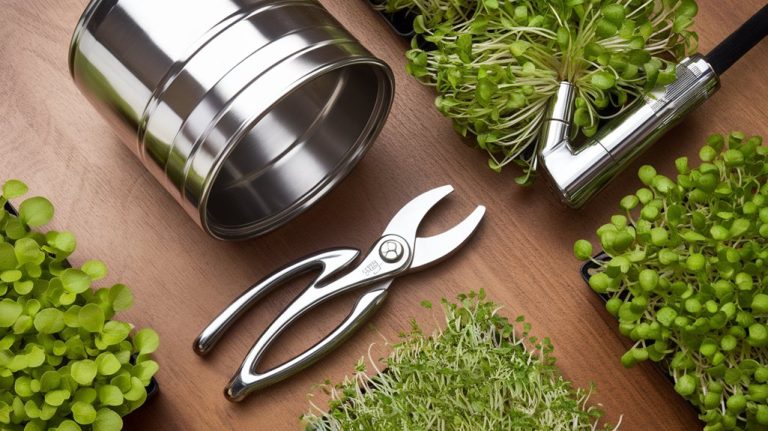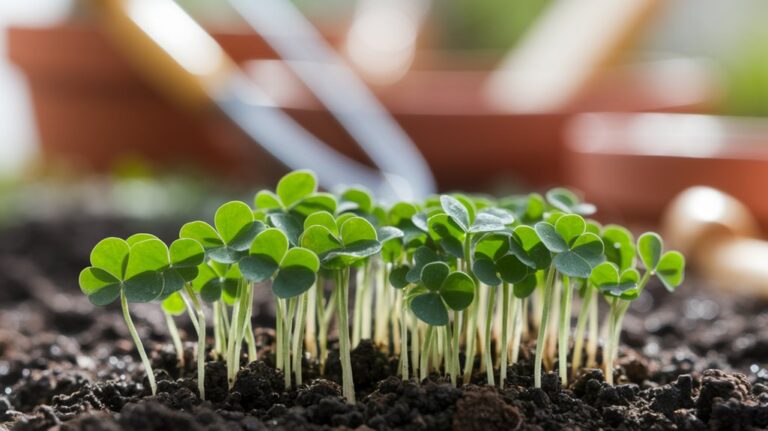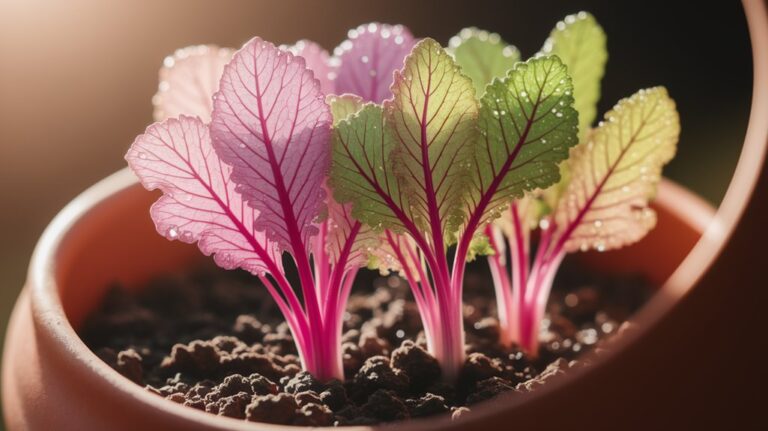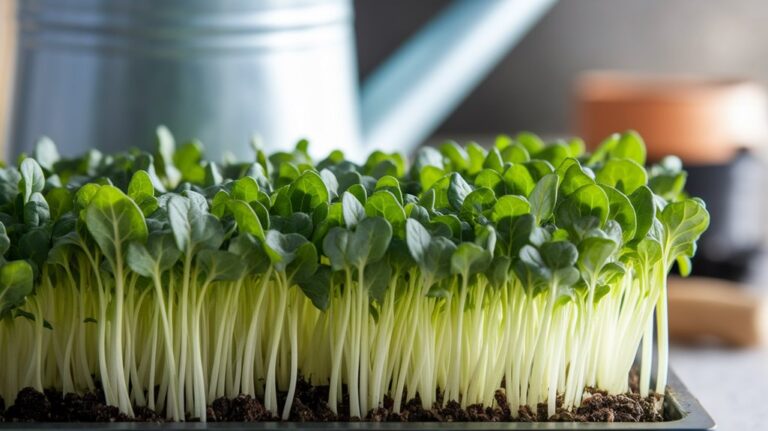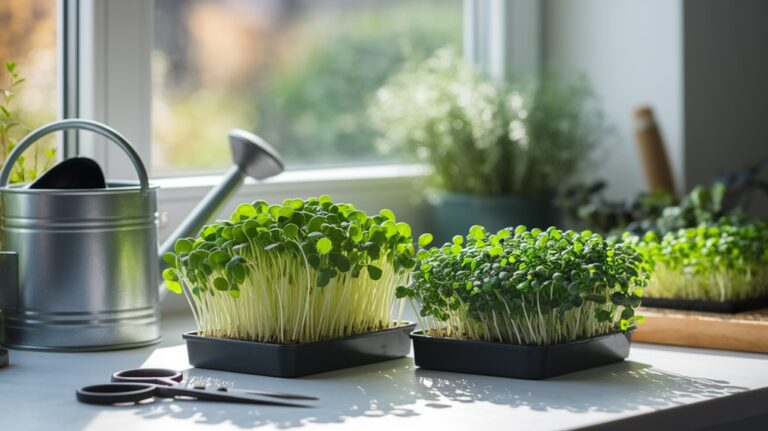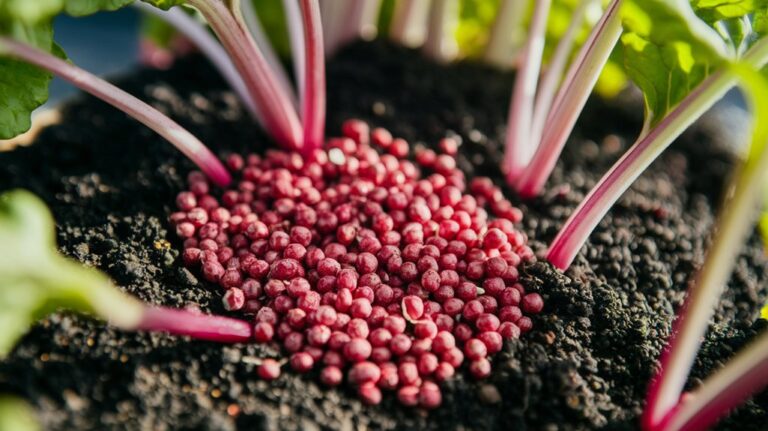Microgreens Myth-Busting: What You Need to Know
Microgreens aren’t just baby plants—they offer unique flavors and significant nutritional benefits, often boasting higher nutrient levels than mature varieties. They’re not reserved for gourmet chefs; anyone can easily grow them at home. Plus, they’re economical and can help reduce food waste. It’s a myth that all microgreens are the same; each type has distinct qualities. You might be surprised by their potential. Stick with me to uncover more about these nutritious greens and how to enjoy them.
Key Takeaways
- Microgreens are highly nutritious, often containing 40 times more nutrients than mature plants, contrary to the misconception of being nutritionally insignificant.
- Growing microgreens at home is easy and requires minimal effort, making it accessible for everyone, not just experienced gardeners.
- Microgreens are versatile and can enhance everyday meals, challenging the belief that they are only for gourmet cooking.
- The perceived high cost of microgreens is often due to packaging; buying in bulk reduces expenses significantly.
- Microgreens support sustainability by reducing food waste and can be grown year-round, regardless of climate, promoting local food systems.
Microgreens Are Just Baby Plants
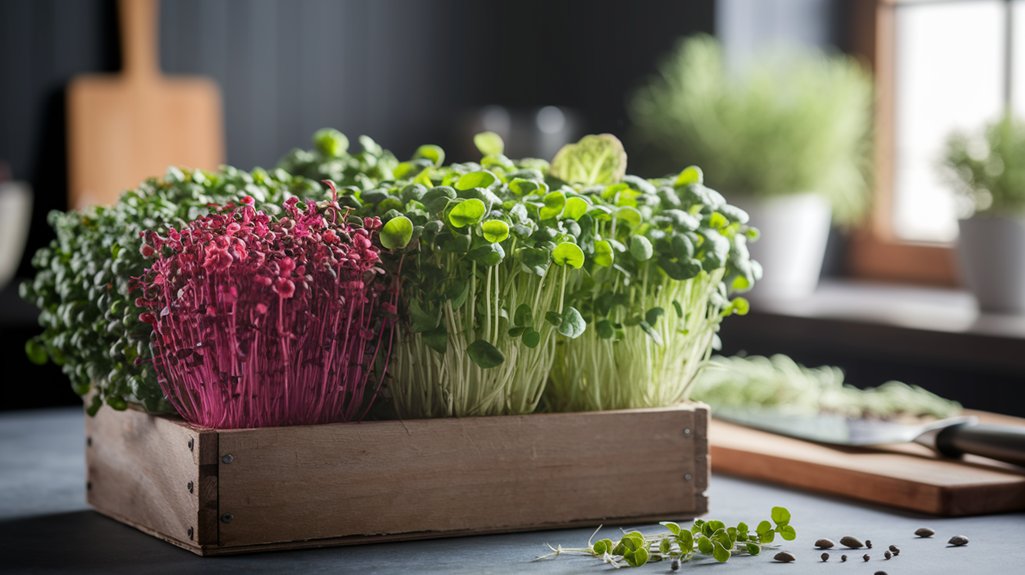
While many people think of microgreens as merely baby plants, this perspective fails to capture their true value. These tiny greens, harvested just after the first true leaves develop, are packed with nutrients, often containing higher concentrations of vitamins and minerals compared to their mature counterparts.
For instance, studies show that microgreens like broccoli, kale, and arugula can have up to 40 times more nutrients than fully grown plants. They’re not just cute garnishes; they’re powerhouses of flavor and nutrition.
Incorporating microgreens into your diet can elevate your meals while providing health benefits. So, the next time you see them, remember they’re more than just seedlings; they’re a concentrated source of goodness waiting to enhance your culinary experience.
All Microgreens Are the Same
Many people mistakenly believe that all microgreens are the same, but this couldn’t be further from the truth.
Different types of microgreens offer unique flavors, textures, and nutritional profiles. Here’s what sets them apart:
- Variety: From arugula to basil, each type has distinct taste and uses in dishes.
- Nutritional Content: Some microgreens pack more vitamins and antioxidants than others—like broccoli vs. radish.
- Growth Conditions: Factors such as light and soil type can affect their growth and flavor, making some more robust than others.
Understanding these differences can enhance your culinary experience and health benefits.
Microgreens Are Superfoods
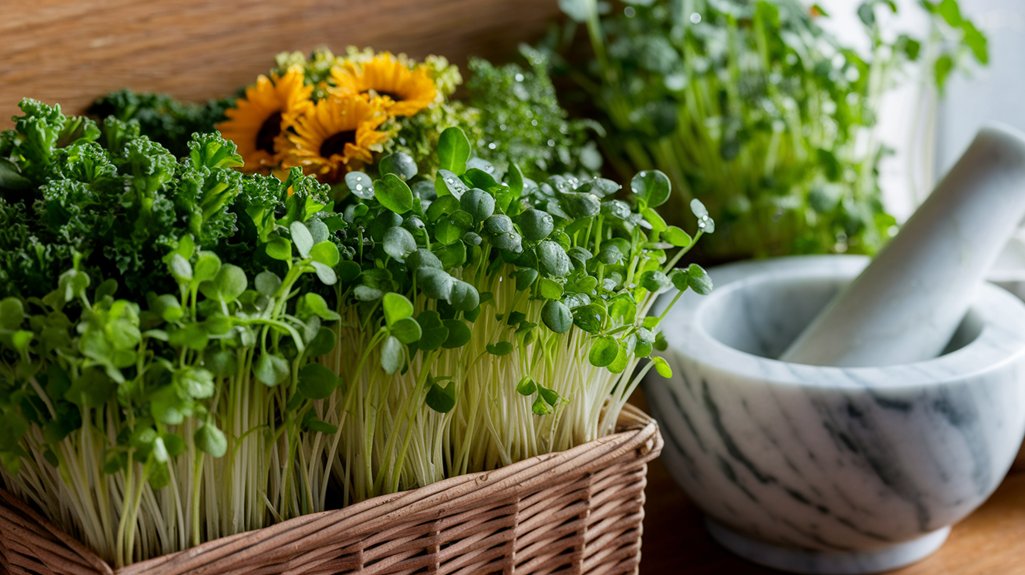
Exploring the diverse world of microgreens reveals their impressive nutritional benefits, often earning them the title of “superfoods.” Packed with vitamins, minerals, and antioxidants, these tiny greens can significantly enhance your diet.
For instance, studies show that microgreens like kale and radish can contain up to 40 times more nutrients than their mature counterparts. This concentration makes them a valuable addition to salads, smoothies, and sandwiches.
What’s more, they’re low in calories yet high in flavor, making them an ideal choice for health-conscious eaters. While the term “superfood” can be subjective, the evidence supporting the nutritional advantages of microgreens is compelling.
Growing Microgreens Is Difficult
Growing microgreens isn’t as difficult as some might think. In fact, with a few simple steps, you can easily cultivate these nutrient-dense plants right at home. Here’s what you need to get started:
- Seeds: Choose your favorite varieties, such as radish, basil, or sunflower. They sprout quickly and taste great.
- Medium: Use a quality growing medium like coconut coir or potting soil. This helps retain moisture and provides essential nutrients.
- Light & Water: Place your trays in a well-lit area or use grow lights. Keep the soil moist but not soggy for the best growth.
Before you know it, you’ll have a vibrant crop of microgreens ready to enhance your meals. It’s easy and rewarding!
Microgreens Are Only for Gourmet Cooking
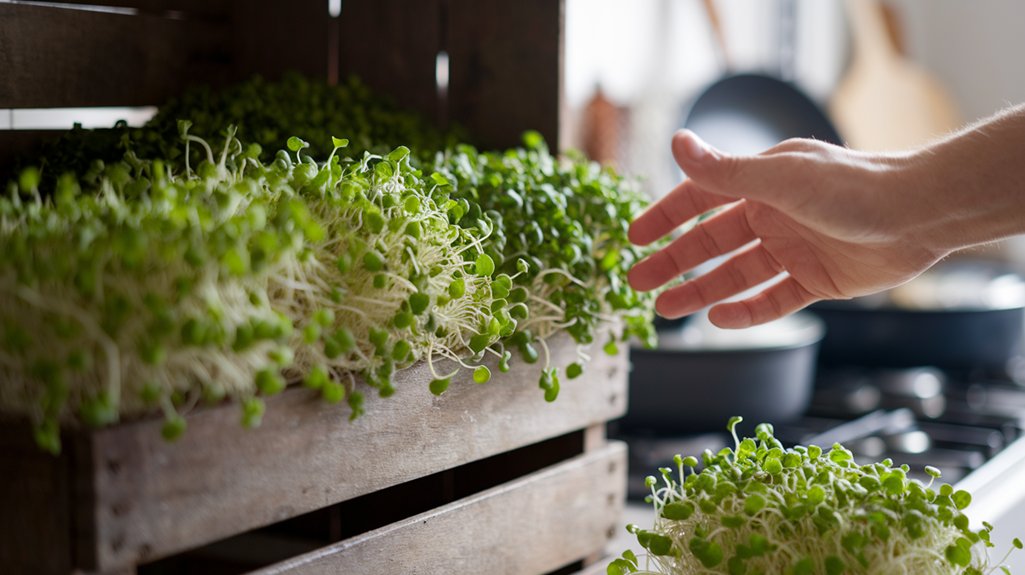
I often hear the claim that microgreens are only for gourmet cooking, but that’s simply not true.
These tiny plants aren’t just fancy garnishes; they pack a nutritional punch and can enhance everyday meals, from salads to sandwiches.
Their versatility makes them a great addition to any kitchen, not just high-end restaurants.
Versatile Culinary Uses
While some might think microgreens are reserved for upscale restaurants, their versatility in everyday cooking proves otherwise.
I’ve found that incorporating microgreens into my meals elevates them effortlessly. Here are three simple ways to use microgreens:
- Salads: Toss a handful into your salad for a burst of flavor and color.
- Sandwiches: Replace lettuce with microgreens for added texture and nutrition in your favorite sandwiches.
- Garnish: Use them as a vibrant garnish for soups or main dishes to enhance presentation.
Microgreens not only add visual appeal but also bring unique flavors to everyday dishes.
Nutritional Powerhouses
Although many people associate microgreens solely with gourmet cooking, they’re actually packed with nutrients that can benefit anyone’s diet. These tiny greens are often overlooked, but they can provide a concentrated source of vitamins, minerals, and antioxidants.
Here’s a quick comparison of some popular microgreens and their nutritional benefits:
| Microgreen | Nutritional Benefit |
|---|---|
| Broccoli | High in sulforaphane |
| Radish | Rich in vitamin C |
| Sunflower | Packed with healthy fats |
Incorporating microgreens into your meals isn’t just for the culinary elite. They’re easy to grow and can enhance the nutritional profile of everyday dishes. So why not add them to your salads, smoothies, or sandwiches? Your body will thank you!
Microgreens Have No Nutritional Value
Microgreens often face skepticism regarding their nutritional value, yet research consistently shows they pack a powerful punch.
In fact, many studies highlight their impressive nutrient density. Here are three key benefits that might surprise you:
- Vitamins and Minerals: Microgreens can contain up to 40 times more vitamins and minerals than their mature counterparts.
- Antioxidants: They’re rich in antioxidants, which help combat oxidative stress and may reduce the risk of chronic diseases.
- Flavor and Variety: Microgreens come in diverse flavors, making them a tasty addition to any dish while boosting its nutritional profile.
You Can’t Grow Microgreens at Home
You might think growing microgreens at home is a challenge, but I’m here to show you it’s actually quite easy.
With just a small amount of space and some simple techniques, anyone can cultivate these nutritious greens right in their kitchen.
Let’s explore how you can get started without needing a green thumb!
Easy Home Growing Techniques
Growing microgreens at home might seem daunting, but it’s actually quite simple and rewarding.
I’ve discovered a few easy techniques that anyone can master:
- Choose Your Seeds: Start with seeds like radish, basil, or kale. They sprout quickly and pack a flavor punch.
- Use Shallow Containers: Any shallow tray or even a recycled container works well. Just make sure it has drainage holes.
- Provide Proper Light and Water: Place your containers in a sunny spot or use grow lights. Keep the soil moist, but not soggy.
Minimal Space Requirements
Many people believe that cultivating microgreens at home requires ample space, but that’s simply not true.
I’ve found that you can grow these nutrient-packed greens in surprisingly small areas. A windowsill, countertop, or even a small shelf can serve as your microgreen garden. All you need is a shallow container, potting soil, and some seeds.
Microgreens thrive in minimal light and just a little water, making them ideal for urban dwellers or anyone with limited gardening space.
In fact, they can grow in as little as 10 days, providing you with fresh produce without taking up much room.
Microgreens Are Expensive to Buy
While it might seem like microgreens come with a hefty price tag, I’ve found that their cost is often inflated due to factors like packaging and marketing.
In reality, growing microgreens at home can be quite economical. Here are three reasons why:
- Minimal Investment: All you need are seeds, soil, and containers, which can be reused multiple times.
- Fast Growth: Most microgreens are ready to harvest within 7-21 days, allowing for quick turnover and fresh greens.
- Bulk Savings: Buying seeds in bulk can significantly reduce the cost per serving compared to store prices.
Frequently Asked Questions
What Are the Best Microgreens to Grow for Beginners?
When I started growing microgreens, I found that radish, pea shoots, and sunflower were the easiest for beginners.
Radish seeds sprout quickly and have a peppery taste, while pea shoots are sweet and tender.
Sunflower microgreens are hearty and nutritious.
I love how they all thrive in just a week or two with minimal effort.
If you’re just starting out, these varieties are a great way to build your confidence in gardening.
How Long Do Microgreens Take to Grow?
Microgreens typically take about 7 to 21 days to grow, depending on the variety.
I’ve found that faster-growing types like radish or mustard can be ready in just a week, while slower ones like basil may take closer to two weeks.
I always ensure they’ve enough light and moisture to thrive.
Harvesting them at the right time ensures maximum flavor and nutrients, so I keep a close eye on their progress.
Can I Grow Microgreens Indoors Without Sunlight?
Absolutely, you can grow microgreens indoors without sunlight!
I’ve had great success using grow lights to provide the necessary light for my microgreens. These lights mimic natural sunlight, allowing the plants to thrive.
Just make sure to keep them on for about 12-16 hours a day.
I’ve found that using a mix of grow lights can enhance growth, so don’t hesitate to experiment a bit to see what works best for you!
Are Microgreens Safe for Pets to Consume?
I often wonder if microgreens are safe for pets, and the answer isn’t straightforward.
While many microgreens like peas and sunflowers are generally safe, some varieties, like arugula, can be harmful.
It’s crucial to research each type before sharing them with your furry friends. Always consult your vet if you’re unsure.
I recommend introducing new foods slowly to monitor any reactions, ensuring a safe treat for your pets!
How Can I Store Harvested Microgreens for Freshness?
To keep harvested microgreens fresh, I store them in a sealed container lined with a damp paper towel.
This method helps maintain moisture without making them soggy. I place the container in the refrigerator, where they can last up to a week.
It’s essential not to wash them until I’m ready to use them, as excess moisture can lead to spoilage.
Enjoying fresh microgreens is all about proper storage!
Conclusion
In conclusion, microgreens are much more than just baby plants; they vary in flavor, nutrition, and growing methods. They’re not just for gourmet dishes and can be easily grown at home. While some may tout them as superfoods, it’s essential to understand their place in a balanced diet. By dispelling these common myths, I hope you feel empowered to explore the world of microgreens and potentially incorporate them into your meals without breaking the bank.


